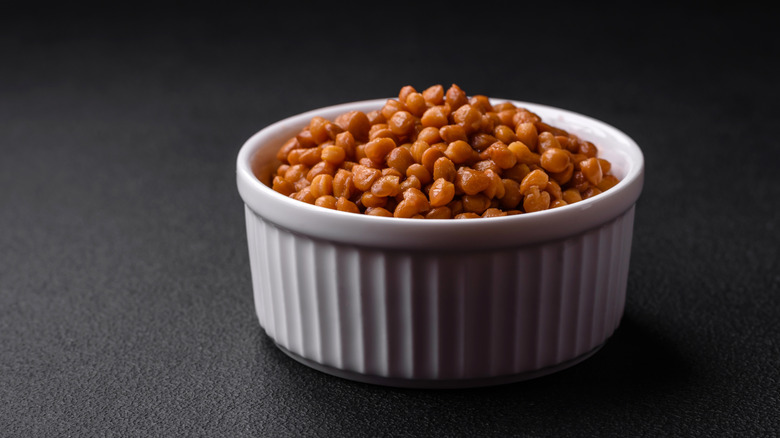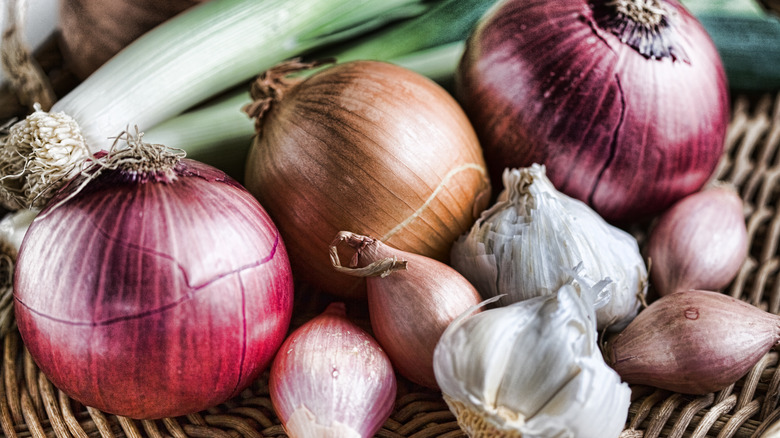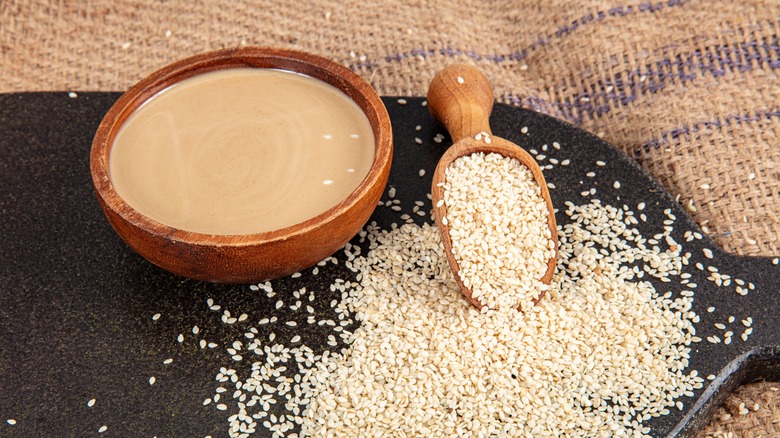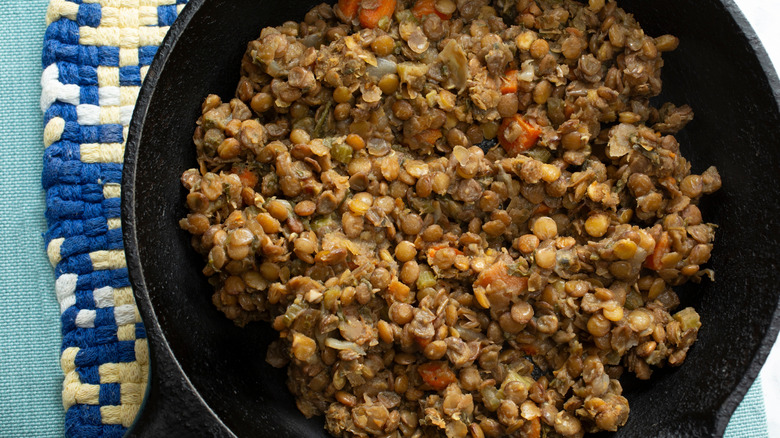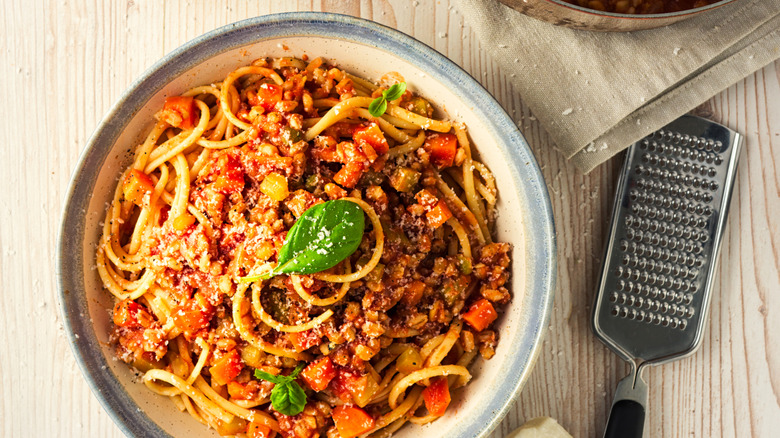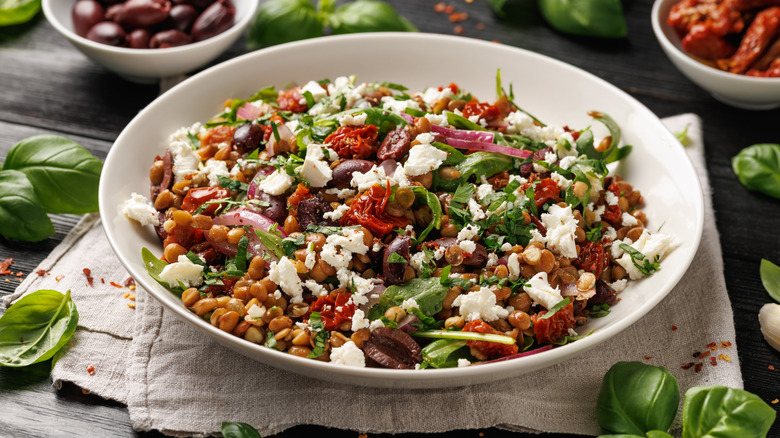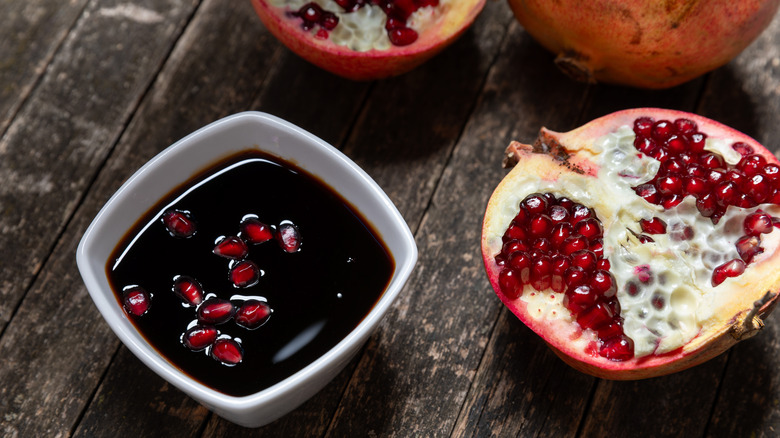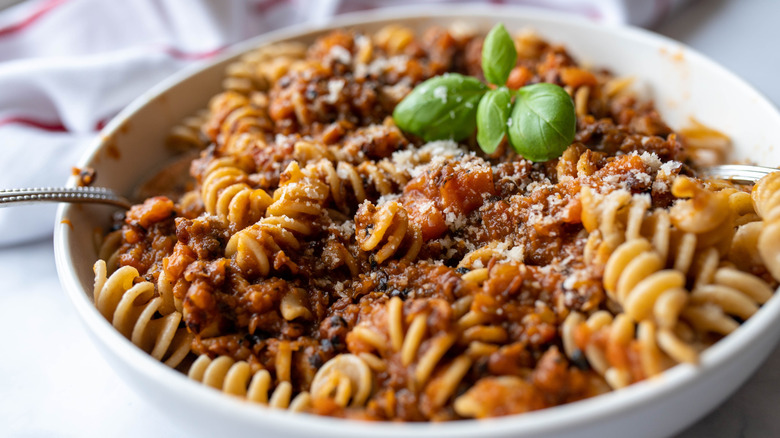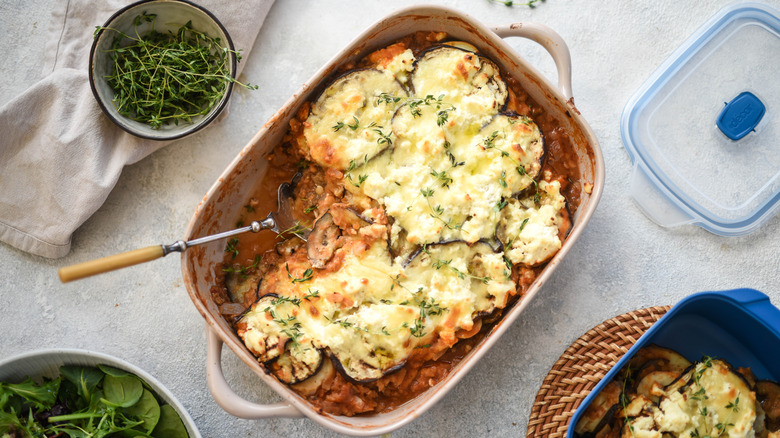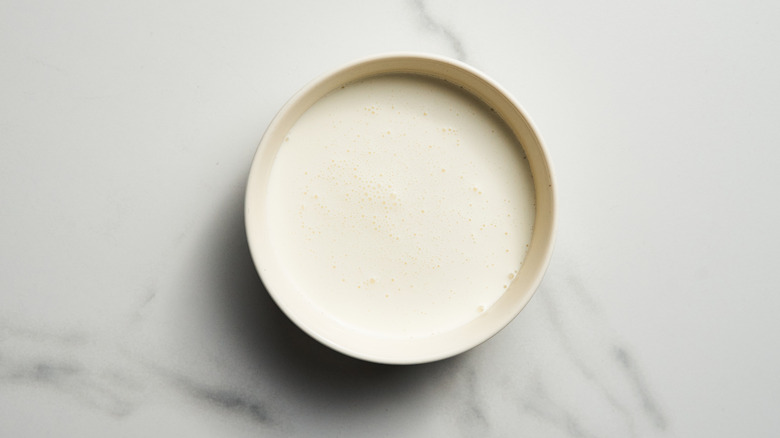13 Ways To Upgrade Canned Lentils
Canned lentils might not be the most exciting of foods. The thought of them probably doesn't have you salivating, but there's more to them than you first imagine. Plus, there are plenty of ways to upgrade canned lentils to make them more exciting. This way, they become the base for a delicious meal that's way tastier and more satisfying than it rightfully should be.
Packed with protein, among other nutrients, lentils are an excellent part of a balanced diet. And when you get them from a can, it makes it even more quick and simple to throw together a meal. No need to simmer them and wait for them to cook through, just throw them in with the other ingredients and heat them up — it only takes a few minutes, depending on the recipe.
We've collected some of the best ways to level up canned lentils. Some of these techniques come from recipes that usually call for dried ones, which is part of what makes them taste less like they came from a can and more like they were cooked from scratch. Take note and prepare to have some of the tastiest lentils of your life.
1. Add some aromatics
Aromatics are those fragrant, flavorful ingredients that give recipes a boost. Ever wondered why so many savory recipes start with onions and garlic? Well, that's because they're aromatics and they take a dish from bland to flavorful. You can add aromatics to your canned lentils to level them up.
Onions and garlic aren't the only aromatics out there, though. In French cooking, many dishes start with a mirepoix, which is a mix of equal parts diced onion, celery, and carrot. On a similar note, Cajun dishes often use the "holy trinity" as a base for dishes — onion, celery, and green bell pepper. Other options include ginger, lemongrass, leeks, and green onions. Think about the flavor profile of your dish and match this to the right combination of aromatics.
But you'll get the most out of them if they're cooked. So, start by sautéing your choice of aromatic ingredients in butter and oil until softened and fragrant. At this point, you can add canned lentils and seasonings. This gives you a tasty side dish on its own, but you could make it a main dish by adding extra veggies and serving it with rice or pasta. A drizzle of olive oil on top adds the finishing touch.
2. Bloom spices and mix them with your lentils
Adding some spices to your lentils seems like an obvious way to upgrade them, but if you stir through raw spices before serving, you can end up with a flat, flavorless dish. A better idea is to bloom your spices before mixing them in. This gives you much bolder and tastier results.
But what does it really mean to bloom spices? Well, all this term refers to is heating spices with a little bit of fat. You just heat oil or melt some butter in a skillet or frying pan and add your spices, which can be ground or whole. Then let them cook in the pan for a few minutes until they become noticeably more fragrant. Heating them in fat this way allows more flavor molecules to be released so they taste stronger and more complex.
Once you've bloomed your spices, you can add lentils on their own, or you could use them as a base for a sauce for lentils. For instance, you might add tomatoes and let those cook down before adding lentils and other vegetables. Or you could combine this technique with aromatics — sautéing onion and garlic before adding more oil to the pan and blooming spices in it. However, even just bloomed spices and lentils together are tasty enough on their own.
3. Smother them in whipped tahini
Tahini sauce is a delicious topping for canned lentils. Whether you've just cooked lentils with aromatics and spices or making a more elaborate dish, a drizzle of tahini over the top gives you a rich, earthy contrast. But whipped tahini is even better than plain tahini sauce.
Whipped tahini is an emulsion, making it lighter and creamier than regular tahini sauce. It ends up with a texture similar to mayonnaise, so it's spoonable and an excellent topping for all kinds of canned lentil recipes. All you need to do is blitz together tahini paste, water, oil, and seasonings with a stick blender for a minute or two and you've got yourself a tasty topping to level up your lentils.
It's so simple and adds loads of flavor, so it will likely become your go-to addition. You can adjust how you season it depending on the dish, but lemon juice is a great addition, giving it some brightness to cut through the intense sesame flavor of tahini. Garlic also adds extra flavor, whether you opt for the bold punch of raw garlic or the milder notes of cooked garlic. And, naturally, you'll need some salt to balance it and help bring out the other flavors.
4. Crisp them in a skillet
Texture is more important in food than a lot of people realize. There's a reason why you might want that piece of crispy iceberg lettuce in your burger or you sprinkle toasted nuts over your oatmeal — different textures can make dishes more interesting. So if you're bored of soft, creamy canned lentils, perhaps you'd prefer crispy ones.
It's extremely easy to crisp them up in a skillet. Simply heat up a little olive oil — or another oil of your choice — then add a can of rinsed, dried lentils. Drying them helps to get a crispier exterior, so rinse them ahead of time and leave them to dry for a while or pat them dry with a paper towel. Then you just toss them in the pan and cook them until they get crisp.
You can add your choice of herbs, spices, and other seasonings. Lentils are versatile so you could add anything from smoked paprika and garlic powder to garam masala, rosemary or nutritional yeast. It's easy to adjust these seasonings to suit whatever you're serving the lentils with, and it's a simple way to do something different with them.
5. Serve them Bolognese style
If you're looking for a new way to upgrade canned lentils, consider serving them Bolognese style. They're a great alternative to ground beef for this classic dish, since they're filling and full of protein. It's a great choice if you want to cut out or cut down on meat, or if you're just looking for a cheap and easy dinner idea.
We have a healthy lentil Bolognese recipe that's made with dried lentils, but you can just as easily use canned ones. In fact, it cuts down the cooking time and makes the whole recipe even simpler. Just add your canned lentils at the same point as your canned tomatoes and simmer until the sauce is done. Or, if you want to simmer the sauce slowly to intensify the flavors, simmer everything apart from the lentils, and then add them in the last 10 to 15 minutes of cooking. This will keep them from getting soggy.
You can also use lentils in your usual favorite Bolognese recipe. Just skip the part of the recipe that calls for browning the meat and add a can of lentils instead. Serve it over spaghetti or your favorite pasta shape. Traditionally, Bolognese is served with tagliatelle.
6. Cover them in fresh herbs
Fresh herbs and lentils are a match made in culinary heaven. The great thing about using fresh herbs is that it instantly makes a meal seem fancier, even if it's made using humble ingredients like canned lentils. So you can easily make a meal that's way more impressive than it ought to be.
We have a recipe for a lentil salad with tons of fresh herbs. It uses parsley, basil, mint, and oregano, but pretty much any fresh herbs go with lentils — dill, cilantro, and chives are also good choices. Soft herbs are often better for using raw, though. They're more flavorful when fresh and have a nicer texture when uncooked. Harder herbs like rosemary aren't always the most pleasant to eat raw, unless very finely chopped. The great thing about using canned lentils for a salad recipe is that they don't need to be cooked or heated before use, so it can come together quickly.
You don't just have to use fresh herbs for cold lentil dishes. They're also great sprinkled over hot lentils to boost the flavor, and they can work with all types of lentil dishes. For instance, you might put fresh basil and parsley on a lentil pasta dish. Or you could boost a basic dish of lentils and onions with the addition of fresh herbs.
7. Spice them up
We've already talked about adding spices to your canned lentils but that doesn't necessarily equate to bringing the heat. You can make these little legumes way more punchy by making them spicy. You can adjust this to something that suits your palate, whether your idea of spicy food is something with a few too many grinds of black pepper or a meal smothered in ghost pepper hot sauce.
There are all kinds of fiery dishes you can try, from spicy lentil soup recipes to hot lentil curries. Or you can start with a recipe that isn't spicy and add some heat. You can do this in various ways, so it's up to you to work out what makes sense for the recipe you're putting together.
In some cases, you might add sliced or diced fresh hot peppers when you're sautéing other aromatics, such as garlic and ginger. This is a good way of adapting a dish to your preferred spice level, since you can use a super mild chili, like a poblano, or something intense like a Carolina reaper. You could also add dried red pepper flakes or cayenne powder when you're blooming spices or a chili paste during cooking, such as gochujang or harissa. There's also the option of adding spice to the finished dish, such as drizzling over hot sauce, spooning on some chili crisp, or topping it with a hot pickle. This is good if people you're cooking for have differing spice tolerances.
8. Drizzle in some pomegranate molasses
Drizzle in some pomegranate molasses while heating your lentils to give them an extra layer of flavor. Canned lentils can often be a little flat and one-dimensional in the taste department. It's the trade-off for how quick they are to heat compared to cooking dried ones from scratch. But adding in some flavorful ingredients like this gives them the boost they need.
If you're wondering what pomegranate molasses is, it's a common ingredient in Middle Eastern food, with a flavor that blends sweet and tart notes. Canned lentils can have a slightly earthy flavor and pomegranate molasses helps to balance this out by bringing some brightness from the acidity along with sweetness that can lift the dish.
It's a great addition to any Middle Eastern-inspired lentil dish. However, it can also taste great in recipes that don't have a Middle Eastern influence. When you use a little, it's subtle enough to meld into a dish, so you'd never guess where those sweet and tart notes came from. It can also work as a topping to a dish. So, even if you don't add it during cooking, you could pour a little over the finished lentils to give them some oomph, perhaps with a touch of whipped tahini.
9. Cook them with pasta
There's a classic Italian dish called pasta e lenticchie that literally translates to pasta and lentils. And, well, it pretty much does what it promises. It starts with brown lentils that are cooked until almost soft with aromatics. Dry pasta is then added and the whole lot is cooked together until the pasta is al dente.
You can make a simpler version of this with canned lentils, although you need to adapt it somewhat. To make the lentil part, start by sautéing diced onions, celery, carrots, and garlic until the hardest of the veggies are soft — it's usually the carrots that take longest. Then add the canned lentils and your choice of seasonings, cooking until the lentils are warm. If they dry out, you can deglaze the pan with a little vegetable stock.
Meanwhile, cook some pasta separately until al dente. Drain the pasta, reserving a half-cup or so of the cooking water, then add the pasta and water to the lentils, mixing until everything is combined. It's a forgiving dish, so you don't need precise measurements — just feel it out. Serve the dish with a hearty drizzle of a good-quality olive oil and some Italian hard cheese, like Pecorino Romano or Parmesan.
10. Incorporate cheese
Incorporating cheese into your canned lentil recipes is a great way to take them to the next level. You might not think of cheese and lentils as an obvious pairing, but it can work brilliantly. Plus, there are so many types of cheese, that you have something to suit basically every recipe — and a range of personal preferences.
Salty, intense feta is great crumbled into a lentil salad, especially one with Greek salad elements, like olives, cucumber, and tomatoes. However, if you're looking for a milder option for a salad, fresh buffalo mozzarella is delicious. Halloumi also works well with lentils, whether in a twist on a classic tabbouleh or topping a lentil stew.
As we've already touched on, hard Italian cheeses go great with lentil pasta dishes. However, this could also work with crumbled Stilton or even just a generous grating of cheddar. We're not saying that cheese works with every lentil dish, but there are so many ways to combine it with these legumes. So get creative and raid your fridge for your favorite cheeses.
11. Turn them into moussaka
If you're looking for a vegetarian alternative to an iconic dish, you can upgrade canned lentils by turning them into moussaka. Common in the Middle East and the Balkans, you'll often find ground meat in moussaka, along with eggplant, potatoes, and more. However, replacing the meat with canned lentils not only gives you a vegetarian alternative but also gives you a new and exciting way to use up a can that's been languishing in your pantry.
You can follow our vegetarian lentil moussaka recipe, but it's also possible to adapt existing recipes that contain meat. Our recipe calls for dried red lentils, but it works just as well with canned green or brown ones. In fact, they have more of a ground meat consistency compared to red lentils, which can dissolve into a dish, given a long enough cooking time.
Once you've made the lentil filling, moussaka is topped with a thick bechamel sauce and sometimes topped with cheese. It's cooked until the top is golden and slightly crispy. Yes, it's a fairly time consuming recipe, but it's absolutely worth it.
12. Cook them with cream
Cooking canned lentils with cream is a sure way to level them up. Paired with a rich, creamy sauce, these legumes are far from boring. In fact, you might not be able to stop making creamy lentils once you discover how good they are. You might use heavy cream for this dish, but you could also use non-dairy creams, such as cashew cream or commercial soy or oat cream.
You'll find a range of creamy lentil recipes if you look online. However, it's absolutely the sort of meal that you can whip up without a recipe. There's no single right or wrong way to do it, so you can experiment and make something delicious. It's pretty hard to mess up. Start by sautéing your choice of aromatics — leeks, onions, or shallots and garlic is a great combination for something creamy. Then, add your lentils, cream, and any additional seasonings, like herbs or spices. Cook until hot and serve them with pasta or crust bread with optional extras like olive oil or cheese.
13. Add broth to make a soup
Add some broth to lentils and you have yourself a simple soup. It's a great way to upgrade these canned legumes while making yourself something warming and comforting. You could choose a slow cooker lentil soup recipe or make it on the stovetop. But, either way, it's an easy way to whip up a hearty meal.
While you could throw together something as simple as a flavorful broth with lentils in it, we'd recommend going a little further. Sauté some onion, celery, and carrot before adding your lentils or try mixing things up with some lemongrass and ginger. You could also add small pasta shapes or Asian noodles, such as udon or soba to make it more of a filling main dish. Fresh herbs will also help take your soup up a notch, turning it from a basic broth to something worth cooking again. The broth you use makes a big difference, too. It doesn't have to be homemade, but something you like the flavor of is a must.
